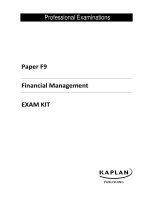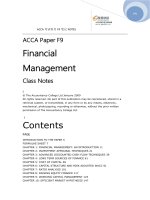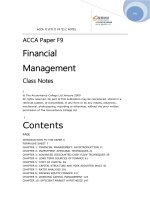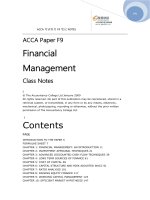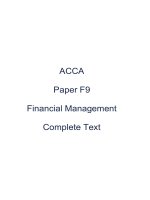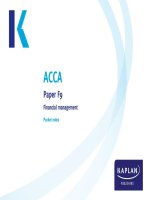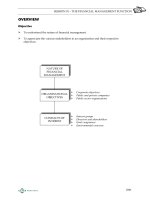ACCA paper f9 financial management complete text
Bạn đang xem bản rút gọn của tài liệu. Xem và tải ngay bản đầy đủ của tài liệu tại đây (1.58 MB, 66 trang )
ACCA
Paper F9
Financial Management
Complete Text
British library cataloguinginpublication data
A catalogue record for this book is available from the British Library.
Published by:
Kaplan Publishing UK
Unit 2 The Business Centre
Molly Millars Lane
Wokingham
Berkshire
RG41 2QZ
ISBN 9781784152178
© Kaplan Financial Limited, 2015
The text in this material and any others made available by any Kaplan Group company does not
amount to advice on a particular matter and should not be taken as such. No reliance should be
placed on the content as the basis for any investment or other decision or in connection with any
advice given to third parties. Please consult your appropriate professional adviser as necessary.
Kaplan Publishing Limited and all other Kaplan group companies expressly disclaim all liability to any
person in respect of any losses or other claims, whether direct, indirect, incidental, consequential or
otherwise arising in relation to the use of such materials.
Printed and bound in Great Britain.
Acknowledgements
We are grateful to the Association of Chartered Certified Accountants and the Chartered Institute of
Management Accountants for permission to reproduce past examination questions. The answers have
been prepared by Kaplan Publishing.
All rights reserved. No part of this publication may be reproduced, stored in a retrieval system, or
transmitted, in any form or by any means, electronic, mechanical, photocopying, recording or
otherwise, without the prior written permission of Kaplan Publishing.
ii
KAPLAN PUBLISHING
Contents
Page
Chapter 1
The financial management function
Chapter 2
Basic investment appraisal techniques
39
Chapter 3
Investment appraisal – discounted cash flow
techniques
61
Chapter 4
Investment appraisal – further aspects of
discounted cash flows
Chapter 5
Asset investment decisions and capital rationing 139
Chapter 6
Investment appraisal under uncertainty
165
Chapter 7
Working capital management
195
Chapter 8
Working capital management – inventory control 235
Chapter 9
Working capital management – accounts
receivable and payable
Chapter 10
Working capital management – cash and funding 299
strategies
Chapter 11
The economic environment for business
343
Chapter 12
Financial markets and the treasury function
373
Chapter 13
Foreign exchange risk
411
Chapter 14
Interest rate risk
457
Chapter 15
Sources of finance
481
Chapter 16
Dividend policy
531
Chapter 17
The cost of capital
543
Chapter 18
Capital structure
605
Chapter 19
Financial ratios
643
Chapter 20
Business valuations and market efficiency
675
Chapter 21
Questions & Answers
721
KAPLAN PUBLISHING
1
103
265
iii
iv
KAPLAN PUBLISHING
chapter
Introduction
v
Introduction
How to Use the Materials
These Kaplan Publishing learning materials have been carefully designed
to make your learning experience as easy as possible and to give you the
best chances of success in your examinations.
The product range contains a number of features to help you in the study
process. They include:
(1) Detailed study guide and syllabus objectives
(2) Description of the examination
(3) Study skills and revision guidance
(4) Complete text or essential text
(5) Question practice
The sections on the study guide, the syllabus objectives, the examination
and study skills should all be read before you commence your studies.
They are designed to familiarise you with the nature and content of the
examination and give you tips on how to best to approach your learning.
The complete text or essential text comprises the main learning
materials and gives guidance as to the importance of topics and where
other related resources can be found. Each chapter includes:
vi
•
The learning objectives contained in each chapter, which have
been carefully mapped to the examining body's own syllabus learning
objectives or outcomes. You should use these to check you have a
clear understanding of all the topics on which you might be assessed
in the examination.
•
The chapter diagram provides a visual reference for the content in
the chapter, giving an overview of the topics and how they link
together.
•
The content for each topic area commences with a brief explanation
or definition to put the topic into context before covering the topic in
detail. You should follow your studying of the content with a review of
the illustration/s. These are worked examples which will help you to
understand better how to apply the content for the topic.
•
Test your understanding sections provide an opportunity to
assess your understanding of the key topics by applying what you
have learned to short questions. Answers can be found at the back of
each chapter.
KAPLAN PUBLISHING
•
Summary diagrams complete each chapter to show the important
links between topics and the overall content of the paper. These
diagrams should be used to check that you have covered and
understood the core topics before moving on.
•
Question practice is provided at the back of each text.
Quality and accuracy are of the utmost importance to us so if you spot an
error in any of our products, please send an email to
with full details, or follow the link to the
feedback form in MyKaplan.
Our Quality Coordinator will work with our technical team to verify the
error and take action to ensure it is corrected in future editions.
Icon Explanations
Definition – Key definitions that you will need to learn from the core
content.
Key Point – Identifies topics that are key to success and are often
examined.
New – Identifies topics that are brand new in papers that build on, and
therefore also contain, learning covered in earlier papers.
Expandable Text – Expandable text provides you with additional
information about a topic area and may help you gain a better
understanding of the core content. Essential text users can access this
additional content online (read it where you need further guidance or skip
over when you are happy with the topic)
Test Your Understanding – Exercises for you to complete to ensure
that you have understood the topics just learned.
Illustration – Worked examples help you understand the core content
better.
Tricky topic – When reviewing these areas care should be taken and all
illustrations and test your understanding exercises should be completed to
ensure that the topic is understood.
Online subscribers
Our online resources are designed to increase the flexibility of your
learning materials and provide you with immediate feedback on how your
studies are progressing. Ask your local customer services staff if you are
not already a subscriber and wish to join.
KAPLAN PUBLISHING
vii
Introduction
If you are subscribed to our online resources you will find:
(1) Online referenceware: reproduces your Complete or Essential Text
online, giving you anytime, anywhere access.
(2) Online testing: provides you with additional online objective testing
so you can practice what you have learned further.
(3) Online performance management: immediate access to your online
testing results. Review your performance by key topics and chart your
achievement through the course relative to your peer group.
Syllabus
Aim
The aim of ACCA Paper F9, Financial management, is to develop the
knowledge and skills expected of a financial manager, relating to issues
affecting investment, financing, and dividend policy decisions.
Main capabilities
•
•
Discuss the role and purpose of the financial management function.
•
•
•
•
•
•
Discuss and apply working capital management techniques.
Assess and discuss the impact of the economic environment on
financial management.
Carry out effective investment appraisal.
Identify and evaluate alternative sources of business finance.
Explain and calculate cost of capital and the factors which affect it.
Discuss and apply principles of business and asset valuations.
Explain and apply risk management techniques in business.
Core areas of the syllabus
•
•
•
•
•
•
•
•
viii
Financial management function.
Financial management environment.
Working capital management.
Investment appraisal.
Business finance.
Cost of capital.
Business valuations.
Risk management.
KAPLAN PUBLISHING
Syllabus objectives
We have reproduced the ACCA’s study guide below, showing where the
objectives are explored within this book.
Within the chapters, we have broken down the extensive information found
in the study guide into easily digestible and relevant sections, called
Content Objectives. These correspond to the objectives at the beginning
of each chapter.
Syllabus learning objective and Chapter reference:
A FINANCIAL MANAGEMENT FUNCTION
1 The nature and purpose of financial management
(a) Explain the nature and purpose of financial management.[1] Ch. 1
(b) Explain the relationship between financial management and financial
and management accounting.[1] Ch. 1
2 Financial objectives and the relationship with corporate strategy
(a) Discuss the relationship between financial objectives, corporate
objectives and corporate strategy.[2] Ch. 1
(b) Identify and describe a variety of financial objectives, including:
[2] Ch.1
(i) shareholder wealth maximisation
(ii) profit maximisation
(iii) earnings per share growth.
3 Stakeholders and impact on corporate objectives
(a) Identify the range of stakeholders and their objectives.[2] Ch. 1
(b) Discuss the possible conflict between stakeholder objectives.[2]Ch. 1
(c) Discuss the role of management in meeting stakeholder objectives,
including the application of agency theory.[2]Ch. 1
(d) Describe and apply ways of measuring achievement of corporate
objectives including:[2] Ch. 19
(i) ratio analysis using appropriate ratios such as return on capital
employed, return on equity, earnings per share and dividend per
share
(ii) changes in dividends and share prices as part of total
shareholder return.
KAPLAN PUBLISHING
ix
Introduction
(e) Explain ways to encourage the achievement of stakeholder
objectives, including:[2] Ch. 1
(i) managerial reward schemes such as share options and
performancerelated pay
(ii) regulatory requirements such as corporate governance codes of
best practice and stock exchange listing regulations
4 Financial and other objectives in notforprofit organisations
(a)
(b)
(c)
Discuss the impact of notforprofit status on financial and other
objectives.[2] Ch. 1
Discuss the nature and importance of Value for Money as an
objective in notforprofit organisations.[2] Ch. 1
Discuss ways of measuring the achievement of objectives in not
forprofit organisations.[2] Ch. 1
B FINANCIAL MANAGEMENT ENVIRONMENT
1 The economic environment for business
(a) Identify and explain the main macroeconomic policy targets.[1] Ch. 11
(b) Define and discuss the role of fiscal, monetary, interest rate and
exchange rate policies in achieving macroeconomic policy targets.
[1] Ch. 11
(c) Explain how government economic policy interacts with planning and
decisionmaking in business.[2] Ch. 11
(d) Explain the need for and the interaction with planning and decision
making in business of:[1] Ch. 11
(i) competition policy
(ii) government assistance for business
(iii) green policies
(iv) corporate governance regulation.[2]
2 The nature and role of financial markets and institutions
(a) Identify the nature and role of money and capital markets, both
nationally and internationally.[2] Ch. 12
(b) Explain the role of financial intermediaries.[1] Ch. 12
(c) Explain the functions of a stock market and a corporate bond market.
[2] Ch. 12
(d) Explain the nature and features of different securities in relation to the
risk/return tradeoff.[2] Ch. 15
x
KAPLAN PUBLISHING
3 The nature and role of the money market
(a) Describe the role of the money markets in:[1] Ch. 12 / 13 / 14
(i) Providing shortterm liquidity to industry and the public sector
(ii) Providing shortterm trade finance
(iii) Allowing an organisation to manage its exposure to foreign
currency risk and interest rate risk
(b) Explain the role of banks and other financial institutions in the
operation of the money markets.[2] Ch. 12
(c) Explain the characteristics and role of the principal money market
instruments:[2] Ch. 12
(i) Interestbearing instruments
(ii) Discount instruments
(iii) Derivative products.
C WORKING CAPITAL MANAGEMENT
1 The nature, elements and importance of working capital
(a) Describe the nature of working capital and identify its elements.
[1] Ch. 7
(b) Identify the objectives of working capital management in terms of
liquidity and profitability, and discuss the conflict between them.
[2] Ch. 7
(c) Discuss the central role of working capital management in financial
management.[2] Ch. 7
2 Management of inventories, accounts receivable, accounts
payable and cash
(a) Explain the cash operating cycle and the role of accounts payable
and receivable.[2] Ch. 7
(b) Explain and apply relevant accounting ratios, including:[2] Ch. 7
(i) current ratio and quick ratio
(ii) inventory turnover ratio, average collection period and average
payable period
(iii) sales revenue/net working capital ratio.
(c) Discuss, apply and evaluate the use of relevant techniques in
managing inventory, including the Economic Order Quantity model
and JustinTime techniques.[2] Ch. 8
KAPLAN PUBLISHING
xi
Introduction
(d) Discuss, apply and evaluate the use of relevant techniques in
managing accounts receivable, including: Ch. 9
(i) assessing creditworthiness[1]
(ii) managing accounts receivable[1]
(iii) collecting amounts owing[1]
(iv) offering early settlement discounts[2]
(v) using factoring and invoice discounting[2]
(vi) managing foreign accounts receivable.[2]
(e) Discuss and apply the use of relevant techniques in managing
accounts payable, including: Ch. 9
(i) using trade credit effectively[1]
(ii) evaluating the benefits of discounts for early settlement and bulk
purchase[2]
(iii) managing foreign accounts payable.[1]
(f)
Explain the various reasons for holding cash, and discuss and apply
the use of relevant techniques in managing cash, including:[2] Ch. 10
(i) preparing cash flow forecasts to determine future cash flows and
cash balances
(ii) assessing the benefits of centralised treasury management and
cash control
(iii) cash management models, such as the Baumol model and the
MillerOrr model
(iv) investing shortterm
3 Determining working capital needs and funding strategies
(a) Calculate the level of working capital investment in current assets and
discuss the key factors determining this level, including:[2] Ch.7
(i) the length of the working capital cycle and terms of trade
(ii) an organisation’s policy on the level of investment in current
assets
(iii) the industry in which the organisation operates.
xii
KAPLAN PUBLISHING
(b) Describe and discuss the key factors in determining working capital
funding strategies, including:[2] Ch.7
(i) the distinction between permanent and fluctuating current assets
(ii) the relative cost and risk of shortterm and longterm finance
(iii) the matching principle
(iv) the relative costs and benefits of aggressive, conservative and
matching funding policies management attitudes to risk, previous
funding decisions and organisation size.[1]
(v) management attitudes to risk, previous funding decisions and
organisation size:[1]
D INVESTMENT APPRAISAL
1 Investment appraisal process techniques
(a) Identify and calculate relevant cash flows for investment projects.
[2] Ch.2
(b) Calculate payback period and discuss the usefulness of payback as
an investment appraisal method.[2] Ch.2
(c) Calculate return on capital employed (accounting rate of return) and
discuss its usefulness as an investment appraisal method.[2] Ch.2
(d) Calculate net present value and discuss its usefulness as an
investment appraisal method.[2] Ch.3
(e) Calculate internal rate of return and discuss its usefulness as an
investment appraisal method.[2] Ch.3
(f) Discuss the superiority of DCF methods over nonDCF methods.
[2] Ch.3
(g) Discuss the relative merits of NPV and IRR.[2] Ch. 3
(h) Calculate discounted payback and discuss its usefulness as an
investment appraisal method.[2] Ch. 6
2 Allowing for inflation and taxation in DCF
(a) Apply and discuss the realterms and nominalterms approaches to
investment appraisal.[2] Ch.4
(b) Calculate the taxation effects of relevant cash flows, including the tax
benefits of taxallowable depreciation and the tax liabilities of taxable
profit.[2] Ch.4
(c) Calculate and apply before and aftertax discount rates.[2] Ch.17
KAPLAN PUBLISHING
xiii
Introduction
3 Adjusting for risk and uncertainty in investment appraisal
(a) Describe and discuss the difference between risk and uncertainty in
relation to probabilities and increasing project life.[2] Ch.6
(b) Apply sensitivity analysis to investment projects and discuss the
usefulness of sensitivity analysis in assisting investment decisions.
[2] Ch.6
(c) Apply probability analysis to investment projects and discuss the
usefulness of probability analysis in assisting investment decisions.
[2] Ch.6
(d) Apply and discuss other techniques of adjusting for risk and
uncertainty in investment appraisal, including: Ch.6
(i) simulation[1]
(ii) adjusted payback[1]
(iii) riskadjusted discount rates.[2]
4 Specific investment decisions (Lease or buy, asset replacement,
capital rationing, etc)
(a) Evaluate leasing and borrowing to buy using the beforeand aftertax
costs of debt.[2] Ch.5
(b) Evaluate asset replacement decisions using equivalent annual cost.
[2] Ch.5
(c) Evaluate investment decisions under singleperiod capital rationing,
including:[2] Ch.5
(i) the calculation of profitability indexes for divisible investment
projects
(ii) the calculation of the NPV of combinations of nondivisible
investment projects
(iii) a discussion of the reasons for capital rationing.
E BUSINESS FINANCE
1 Sources of and raising business finance
(a) Identify and discuss the range of shortterm sources of finance
available to businesses, including:[2] Ch.15
(i) overdraft
(ii) shortterm loan
(iii) trade credit
(iv) lease finance.
xiv
KAPLAN PUBLISHING
(b) Identify and discuss the range of longterm sources of finance
available to businesses, including:[2] Ch.15
(i) equity finance
(ii) debt finance
(iii) lease finance
(iv) venture capital.
(c) Identify and discuss methods of raising equity finance, including:
[2] Ch.15
(i) rights issue
(ii) placing
(iii) public offer
(iv) stock exchange listing.
(d) Identify and discuss methods of raising short and long term Islamic
finance including: [1] Ch.15
(i) major difference between Islamic finance and other forms of
business finance
(ii) The concept of Riba (interest) and how returns are made by
Islamic financial securities
(iii) Islamic financial instruments available to businesses including
(iv) murabaha (trade credit)
(v) Ijara (lease finance)
(vi) mudaraba (equity finance)
(vii) sukuk (debt finance)
(viii)musharaka (venture capital)
(note calculations are not required)
(e) Identify and discuss internal sources of finance, including:[2] Ch.15
(i) retained earnings
(ii) increasing working capital management efficiency.
(iii) the relationship between the dividend decision and the financing
decision[2] Ch.16
(iv) the theoretical approaches to, and the practical influences on, the
dividend decision, including legal constraints, liquidity,
shareholding expectations and alternatives to cash dividends
[2] Ch.16
KAPLAN PUBLISHING
xv
Introduction
2 Estimating the cost of capital
(a) Estimate the cost of equity, including:[2] Ch.17
(i) Application of the dividend growth model and discussion of its
weaknesses
(ii) Explanation and discussion of systematic and unsystematic risk
(iii) Relationship between portfolio theory and the capital asset
pricing model (CAPM)
(iv) Application of the CAPM, its assumptions, advantages and
disadvantages.
(b) Estimating the cost of debt[2] Ch.17
(i) irredeemable debt
(ii) redeemable debt
(iii) convertible debt
(iv) preference shares
(v) bank debt.
(c) Estimating the overall cost of capital, including:[2] Ch.17
(i) Distinguishing between average and marginal cost of capital
(ii) Calculating the weighted average cost of capital (WACC) using
book value and market value weightings.
3 Sources of finance and their relative costs
(a) Describe the relative riskreturn relationship and the relative costs of
equity and debt.[2] Ch.17
(b) Describe the creditor hierarchy and its connection with the relative
costs of sources of finance.[2] Ch.17
(c) Identify and discuss the problem of high levels of gearing.[2] Ch.18
(d) Assess the impact of sources of finance on financial position,
financial risk and shareholder wealth using appropriate measures,
including: Ch.19
(i) ratio analysis using statement of financial position gearing,
operational and financial gearing, interest coverage ratio and
other relevant ratios[2]
(ii) cash flow forecasting[2]
(iii) leasing or borrowing to buy.[2]
xvi
KAPLAN PUBLISHING
(e) Impact of cost of capital on investments, including:[2] Ch.17
(i) the relationship between company value and cost of capital
(ii) the circumstances under which WACC can be used in
investment appraisal
(iii) the advantages of the CAPM over WACC in determining a
projectspecific cost of capital
(iv) application of CAPM in calculating a project specific discount
rate.
4 Capital structure theories and practical considerations
(a) Describe the traditional view of capital structure and its assumptions.
[2] Ch.18
(b) Describe the views of Miller and Modigliani on capital structure, both
without and with corporate taxation, and their assumptions.[2] Ch.18
(c) Identify a range of capital market imperfections and describe their
impact on the views of Miller and Modigliani on capital structure.
[2] Ch.18
(d) Explain the relevance of pecking order theory to the selection of
sources of finance.[1] Ch.18
5 Finance for small and mediumsized entities (SMEs)
(a) Describe the financing needs of small businesses.[2] Ch.15
(b) Describe the nature of the financing problem for small businesses in
terms of the funding gap, the maturity gap and inadequate security.
[2] Ch.15
(c) Explain measures that may be taken to ease the financing problems
of SMEs, including the responses of government departments and
financial institutions.[1] Ch.15
(d) Identify appropriate sources of finance for SMEs and evaluate the
financial impact of different sources of finance on SMEs.[2] Ch.15
F BUSINESS VALUATIONS
1 Nature and purpose of the valuation of business and financial
assets
(a) Identify and discuss reasons for valuing businesses and financial
assets.[2]Ch.20
(b) Identify information requirements for valuation and discuss the
limitations of different types of information.[2] Ch.20
KAPLAN PUBLISHING
xvii
Introduction
2 Models for the valuation of shares
(a) Assetbased valuation models, including:[2] Ch.20
(i) net book value (statement of financial position basis).
(ii) net realisable value basis.
(iii) net replacement cost basis.
(b) Incomebased valuation models, including:[2] Ch.20
(i) price/earnings ratio method
(ii) earnings yield method
(c) Cash flowbased valuation models, including: [2] Ch.20
(i) dividend valuation model and the dividend growth model
(ii) discounted cash flow basis.
3 The valuation of debt and other financial assets
(a) Apply appropriate valuation methods to:[2] Ch.20
(i) irredeemable debt
(ii) redeemable debt
(iii) convertible debt
(iv) preference shares.
4 Efficient market hypothesis (EMH) and practical considerations
in the valuation of shares
(a) Distinguish between and discuss weak form efficiency, semistrong
form efficiency and strong form efficiency.[2] Ch.20
(b) Discuss practical considerations in the valuation of shares and
businesses, including:[2] Ch.20
(i) marketability and liquidity of shares
(ii) availability and sources of information
(iii) market imperfections and pricing anomalies
(iv) market capitalisation.
(c) Describe the significance of investor speculation and the
explanations of investor decisions offered by behavioural finance.
[1] Ch.20
xviii
KAPLAN PUBLISHING
G RISK MANAGEMENT
1 The nature and types of risk and approaches to risk
management
(a) Describe and discuss different types of foreign currency risk:
[2] Ch.13
(i) translation risk
(ii) transaction risk
(iii) economic risk.
(b) Describe and discuss different types of interest rate risk:[1] Ch.14
(i) gap exposure
(ii) basis risk
2 Causes of exchange rate differences and interest rate
fluctuations
(a) Describe the causes of exchange rate fluctuations, including: Ch.13
(i) balance of payments[1]
(ii) purchasing power parity theory[2]
(iii) interest rate parity theory[2]
(iv) fourway equivalence.[2]
(b) Forecast exchange rates using:[2] Ch.13
(i) purchasing power parity
(ii) interest rate parity.
(c) Describe the causes of interest rate fluctuations, including: [2] Ch.14
(i) structure of interest rates and yield curves
(ii) expectations theory
(iii) liquidity preference theory
(iv) market segmentation.
KAPLAN PUBLISHING
xix
Introduction
3 Hedging techniques for foreign currency risk
(a) Discuss and apply traditional methods of foreign currency risk
management, including: Ch.13
(i) currency of invoice[1]
(ii) netting and matching[2]
(iii) leading and lagging[2]
(iv) forward exchange contracts[2]
(v) money market hedging[2]
(vi) asset and liability management.[1]
(b) Compare and evaluate traditional methods of foreign currency risk
management.[2] Ch.13
(c) Identify the main types of foreign currency derivates used to hedge
foreign currency risk and explain how they are used in hedging.[1] (No
numerical questions will be set on this topic)Ch.13
4 Hedging techniques for interest rate risk
(a) Discuss and apply traditional methods of interest rate risk
management, including: Ch.14
(i) matching and smoothing[1]
(ii) asset and liability management[1]
(iii) forward rate agreements.[2]
(b) Identify the main types of interest rate derivates used to hedge
interest rate risk and explain how they are used in hedging.[1] (No
numerical questions will be set on this topic) Ch.14
The superscript numbers in square brackets indicate the intellectual depth
at which the subject area could be assessed within the examination. Level
1 (knowledge and comprehension) broadly equates with the Knowledge
module, Level 2 (application and analysis) with the Skills module and
Level 3 (synthesis and evaluation) to the Professional level. However,
lower level skills can continue to be assessed as you progress through
each module and level.
xx
KAPLAN PUBLISHING
The examination
Examination format
The syllabus for Paper F9, Financial Management, has the aim of
developing in students the skills expected from a financial manager who
is responsible for the finance function of a business. The paper also
prepares candidates for more advanced and specialist study in Paper
P4, Advanced financial management. All questions are compulsory. The
paper will contain both computational and discursive elements. Some
questions will adopt a scenario/ case study approach.
Section A of the exam comprises 20 multiple choice questions of 2 marks
each. Section B of the exam comprises three 10 mark questions and two
15 mark questions. The two 15 mark questions will come from working
capital management, investment appraisal and business finance areas of
the syllabus. The section A questions and the other questions in section
B can cover any areas of the syllabus. Candidates are provided with a
formulae sheet and tables of discount factors and annuity factors.
Number of marks 100. Total time allowed: 3 hours and 15 minutes
reading time.
Paperbased examination tips
Spend the fifteen minutes of reading time reading the paper and
planning your answers. During the reading time you may annotate the
question paper but not write in the answer booklet. In particular you should
use this time to ensure that you understand the requirements, highlighting
key verbs, consider which parts of the syllabus are relevant and plan key
calculations.
Divide the time you spend on questions in proportion to the marks on
offer. One suggestion for this examination is to allocate 1 and 4/5 minutes
to each mark available, so a 10mark question should be completed in
approximately 18 minutes.
Unless you know exactly how to answer the question, spend some time
planning your answer. Stick to the question and tailor your answer to
what you are asked. Pay particular attention to the verbs in the question.
Spend the last five minutes reading through your answers and making any
additions or corrections.
If you get completely stuck with a question, leave space in your answer
book and return to it later.
KAPLAN PUBLISHING
xxi
Introduction
If you do not understand what a question is asking, state your
assumptions. Even if you do not answer in precisely the way the examiner
hoped, you should be given some credit, if your assumptions are
reasonable.
You should do everything you can to make things easy for the marker. The
marker will find it easier to identify the points you have made if your
answers are legible.
Essay questions: Some questions may contain short essaystyle
requirements. Your essay should have a clear structure. It should contain a
brief introduction, a main section and a conclusion. Be concise. It is better
to write a little about a lot of different points than a great deal about one or
two points.
Computations: It is essential to include all your workings in your
answers. Many computational questions require the use of a standard
format. Be sure you know these formats thoroughly before the exam and
use the layouts that you see in the answers given in this book and in
model answers.
Case studies: Most questions will be based on specific scenarios. To
write a good case study, first identify the area in which there is a problem,
outline the main principles/theories you are going to use to answer the
question, and then apply the principles/theories to the case.
Reports, memos and other documents: some questions ask you to
present your answer in the form of a report or a memo or other document.
So use the correct format – there could be easy marks to gain here.
Study skills and revision guidance
This section aims to give guidance on how to study for your ACCA exams
and to give ideas on how to improve your existing study techniques.
Preparing to study
Set your objectives
Before starting to study decide what you want to achieve – the type of
pass you wish to obtain. This will decide the level of commitment and time
you need to dedicate to your studies.
xxii
KAPLAN PUBLISHING
Devise a study plan
Determine which times of the week you will study.
Split these times into sessions of at least one hour for study of new
material. Any shorter periods could be used for revision or practice.
Put the times you plan to study onto a study plan for the weeks from now
until the exam and set yourself targets for each period of study – in your
sessions make sure you cover the course, course assignments and
revision.
If you are studying for more than one paper at a time, try to vary your
subjects as this can help you to keep interested and see subjects as part
of wider knowledge.
When working through your course, compare your progress with your plan
and, if necessary, replan your work (perhaps including extra sessions) or,
if you are ahead, do some extra revision/practice questions.
Effective studying
Active Reading
You are not expected to learn the text by rote, rather, you must understand
what you are reading and be able to use it to pass the exam and develop
good practice. A good technique to use is SQ3Rs – Survey, Question,
Read, Recall, Review:
(1) Survey the chapter – look at the headings and read the introduction,
summary and objectives, so as to get an overview of what the chapter
deals with.
(2) Question – whilst undertaking the survey, ask yourself the questions
that you hope the chapter will answer for you.
(3) Read through the chapter thoroughly, answering the questions and
making sure you can meet the objectives. Attempt the exercises and
activities in the text, and work through all the examples.
(4) Recall – at the end of each section and at the end of the chapter, try
to recall the main ideas of the section/chapter without referring to the
text. This is best done after a short break of a couple of minutes after
the reading stage.
Review – check that your recall notes are correct. You may also find it
helpful to reread the chapter to try to see the topic(s) it deals with as a
whole.
KAPLAN PUBLISHING
xxiii
Introduction
Notetaking
Taking notes is a useful way of learning, but do not simply copy out the
text. The notes must:
•
•
•
•
•
be in your own words
be concise
cover the key points
be wellorganised
be modified as you study further chapters in this text or in related
ones.
Three ways of taking notes:
Summarise the key points of a chapter.
Make linear notes – a list of headings, divided up with subheadings
listing the key points. If you use linear notes, you can use different colours
to highlight key points and keep topic areas together. Use plenty of space
to make your notes easy to use.
Try a diagrammatic form – the most common of which is a mindmap.
To make a mindmap, put the main heading in the centre of the paper and
put a circle around it. Then draw short lines radiating from this to the main
subheadings, which again have circles around them. Then continue the
process from the subheadings to subsubheadings, advantages,
disadvantages, etc.
Highlighting and underlining
You may find it useful to underline or highlight key points in your study text
– but do be selective. You may also wish to make notes in the margins.
Revision
The best approach to revision is to revise the course as you work through
it. Also try to leave four to six weeks before the exam for final revision.
Make sure you cover the whole syllabus and pay special attention to those
areas where your knowledge is weak. Here are some recommendations:
Read through the text and your notes again and condense your notes into
key phrases. It may help to put key revision points onto index cards to look
at when you have a few minutes to spare.
Review any assignments you have completed and look at where you lost
marks – put more work into those areas where you were weak.
xxiv
KAPLAN PUBLISHING
Practise exam standard questions under timed conditions. If you are
short of time, list the points that you would cover in your answer and then
read the model answer, but do try to complete at least a few questions
under exam conditions.
Also practise producing answer plans and comparing them to the
model answer.
If you are stuck on a topic find somebody (a tutor) to explain it to you.
Read good newspapers and professional journals, especially
ACCA’s Student Accountant – this can give you an advantage in the
exam.
Ensure you know the structure of the exam – how many questions
and of what type you will be expected to answer. During your revision
attempt all the different styles of questions you may be asked.
Further reading
You can find further reading and technical articles under the student
section of ACCA’s website.
KAPLAN PUBLISHING
xxv


